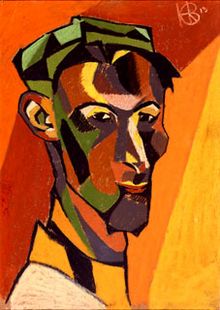Henri Gaudier-Brzeska facts for kids
Quick facts for kids
Henri Gaudier-Brzeska
|
|
|---|---|

Self-portrait, 1913
|
|
| Born |
Henri Gaudier
4 October 1891 St Jean de Braye, near Orléans, France
|
| Died | 5 June 1915 (aged 23) Neuville-Saint-Vaast France
|
| Known for |
|
| Movement | Vorticism |
Henri Gaudier-Brzeska was a French artist and sculptor. He was born on October 4, 1891, and died on June 5, 1915. He created sculptures with a unique, rough style. He often carved directly into materials, leaving the tool marks visible.
Contents
Biography of Henri Gaudier-Brzeska
Henri Gaudier was born in Saint-Jean-de-Braye, a town near Orléans, France. In 1910, he moved to London to become an artist. He learned on his own, without going to art school.
When he moved to London, he was joined by Sophie Brzeska. She was a Polish writer, and she was older than him. They had met in Paris. Henri and Sophie had a close relationship, and he even added her last name, Brzeska, to his own. However, they never got married.
Henri decided to focus on sculpture. He was inspired by his father, who was a carpenter. In England, Gaudier-Brzeska joined a group of artists called Vorticism. This group included famous people like Ezra Pound and Wyndham Lewis. Henri became one of the first members of the London Group.
Around 1912, he was influenced by another sculptor, Jacob Epstein. Henri began to believe that sculptures should not be perfectly smooth and polished like ancient Greek art. Instead, he thought sculptures should look more natural and show the artist's hand. He liked the idea of "direct carving," where the artist carves straight into the material. The marks from the tools would be left on the finished work.
He stopped being interested in the work of Auguste Rodin. Instead, he started studying art from other parts of the world. He looked at pieces in the British Museum and the Victoria and Albert Museum. He couldn't afford large materials. So, he first focused on small sculptures, like Japanese netsuke. Later, he became interested in art from West Africa and the Pacific Islands.
In 1913, he helped create illustrations for a book called The Splendid Wayfaring. He worked with other artists like Claud Lovat Fraser and Edward Gordon Craig. In the same year, Henri Gaudier-Brzeska met Alfred Wolmark, a Jewish artist. He sculpted a bronze bust of Wolmark, and they became good friends.
Gaudier-Brzeska's drawing style was influenced by Chinese writing and poetry. He learned about these at a place Ezra Pound called the "Ezuversity." Pound's studies of Chinese culture led Gaudier-Brzeska to look at Eastern art. He learned how to use simple strokes to show the true nature of a subject. His drawings also show the influence of Cubism.
When World War I began, Gaudier-Brzeska joined the French army. He fought bravely and received an award for his courage. Sadly, he was killed in the trenches at Neuville-Saint-Vaast on June 5, 1915. While in the army, he even sculpted a figure from the butt of a German soldier's rifle. He said he did this "to express a gentler order of feeling."
Henri and Sophie Brzeska's Relationship
Gaudier met Sophie Brzeska when he was 18. She was a Polish writer and had worked as a governess. Several books have been written about Gaudier's art. However, the 1931 book Savage Messiah by H. S. Ede (Jim Ede) focuses on their unique relationship.
Henri was very devoted to Sophie. He even took her last name as his own. Sophie, however, was often distant towards Henri's romantic feelings. She is sometimes not mentioned much in stories about Gaudier's life. The book Savage Messiah mainly focuses on Henri as the artist. But the 1972 film based on the book changed its focus to show more of Sophie and Henri's relationship.
After Henri's death, Sophie Brzeska became very sad. She later died in a special hospital in 1925.
Henri Gaudier-Brzeska's Legacy
Jim Ede bought many of Gaudier-Brzeska's artworks after Sophie Brzeska passed away. Her belongings included many letters that Henri and Sophie had sent to each other. Ede used these letters to write his book Savage Messiah. This book then became the basis for Ken Russell's film of the same name. The end of the film shows many of Henri's sculptures, proving the great art he made in his short life.
Even though he only had four years to develop his art, Gaudier-Brzeska had a big impact on modern sculpture in England and France. His work is kept in many famous museums around the world. These include the Tate Gallery, Kettle's Yard, the Princeton University Art Museum, the Harvard Art Museums, the Museum of Modern Art, the Philadelphia Museum of Art, and the Victoria and Albert Museum. His art is also in the Metropolitan Museum of Art and the Musée National d'Art Moderne in Paris.
The Nasher Museum of Art at Duke University held an exhibition about the Vorticists from 2010 to 2011. This show, called The Vorticists: Rebel Artists in London and New York, 1914–18, included some of Gaudier-Brzeska's work.
Images for kids
See also
 In Spanish: Henri Gaudier-Brzeska para niños
In Spanish: Henri Gaudier-Brzeska para niños




